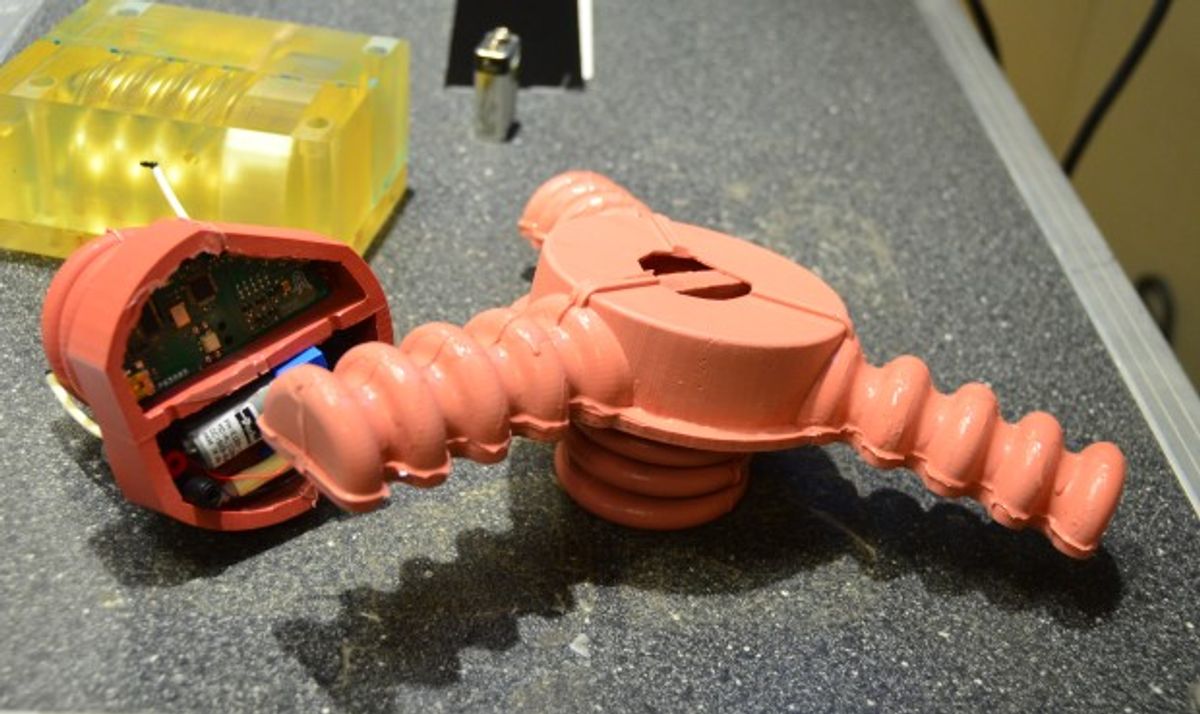Every time we show up to one of these IEEE robotics conferences, we're excited to see things that are new and amazing. We never know what it's going to be, exactly, but this robot right here is the perfect example: something crazy and innovative that also manages to push the bounds of robotics research, with the added bonus that it uses explosions to move. And it looks really, really weird.
This "untethered soft jumping robot," created by Harvard researchers, was presented yesterday at the IEEE International Conference on Intelligent Robots and Systems (IROS), in Chicago. The robot is a three limbed silicone thing with an "explosive actuator" at the bottom that harnesses a butane-oxygen reaction to propel it upward. Just watch:
For the record, the researchers are completely, entirely, 100 percent aware of all of the things that their robot vaguely (or not so vaguely) resembles. Go on, make a joke, I guarantee you that they've heard it before. Heck, they probably heard it yesterday, during the interactive session at IROS, when other researchers stopped by to see the thing. The silicone rubber that the robot is made of is that unfortunate flesh tone because, well, that's what was cheap and available.
The robot's three legs can be inflated pneumatically, which allows it to orient itself to control the direction of launch. Once it's pointing the right way, butane (from an internal canister) and oxygen (generated from a mixture of manganese and hydrogen peroxide) are injected into the springy looking appendage at the bottom. A spark is produced, which ignites the mixture, causing an explosion that launches the robot 0.6 meter (7.5 times its body height) into the air. It's important to note that everything required for the robot to orient and jump is on-board: this is completely untethered and independent of any external infrastructure.
Chemical reactions are appealing because you can get very high power densities. "It's a very efficient way to carry energy around," said Michael T. Tolley, a postdoc at the Harvard Microrobotics Laboratory. There are reasons why most cars, airplanes, and rockets run on controlled explosions: for their weight and volume, you get tremendous amounts of energy, putting batteries completely to shame. Explosions are complicated and messy, and often require a lot of careful management of potentially dangerous ingredients, but this is certainly not the first robot to take advantage of chemical propulsion.
We should point out that this robot is in many ways closely related to that other squishy pink robot from Harvard that we wrote about a week or two ago. The next generation of this robot will be another evolution, one that is an entirely different design, and capable of either self-righting or reliably landing upright, enabling multiple successive jumps. In this case, fuel is not the limiting factor: the robot carries enough reactants with to to make at least 80 jumps. The researchers also mention that future versions could include the ability to grip or adhere to surfaces, which would be pretty awesome... We are now looking forward to soft exploding octopus gecko robots, because what could possibly be better than that.
"An Untethered Jumping Soft Robot," by Michael T. Tolley, Robert F. Shepherd, Michael Karpelson, Nicholas W. Bartlett, Kevin C. Galloway, Michael Wehner, Rui Nunes, George M. Whitesides, and Robert J. Wood, from Harvard University, was presented at IROS 2014 in Chicago.
Evan Ackerman is a senior editor at IEEE Spectrum. Since 2007, he has written over 6,000 articles on robotics and technology. He has a degree in Martian geology and is excellent at playing bagpipes.





